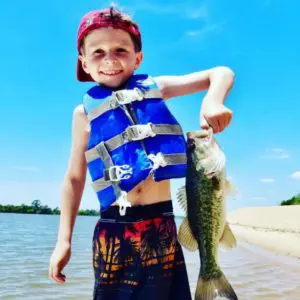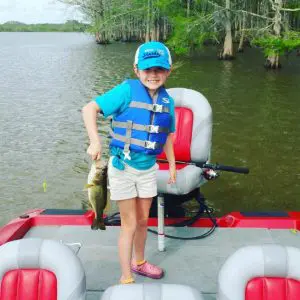You are here: Home > Things to See & Do > Fishing > Types of Fishing >
Freshwater Fishing on the Forgotten Coast
Are you a fan of freshwater fishing? Plan the angling adventure of a lifetime on Florida’s Forgotten Coast! Franklin County offers some of the most exciting and productive freshwater fishing in the Sunshine State.
If you’re ready for some fabulous Florida freshwater fishing, head out to the lower Apalachicola River, Carrabelle River or Ochlockonee River, where you’ll find abundant bass, bream, stripers and catfish. Thanks to the unique topography of these three rivers, fish species grow to impressive sizes in this area. The Apalachicola River, Carrabelle River and Ochlockonee River all flow into the Gulf of Mexico, making Franklin County one of the most ecologically diverse natural water areas in the Southern U.S.
Whether you choose to fish from shore or wade, paddle or motor out on one of our peaceful rivers, you’re certain to enjoy an unforgettable freshwater fishing experience.
Apalachicola River

©Carrie Johnson
The Apalachicola River is Florida's largest river in terms of water volume discharged. Starting from Lake Seminole at the Florida-Georgia border, the Apalachicola River runs 106 miles south through the Panhandle to the town Apalachicola where it meets the Gulf of Mexico.
The most productive fishing spots on the Apalachicola River are the upper river, where the river discharges from Lake Seminole, and the lower river in Franklin County, which is influenced by Apalachicola Bay and the Gulf of Mexico.
The lower Apalachicola River consists of the main river channel and the distributaries that form the delta, including St. Marks River, Little St. Marks River and East River. If you want to fish the river from the shoreline, access is available from the public docks on the Apalachicola waterfront and at the City Dock (Ten-foot Hole) under the Hwy. 98 Bridge.
If you prefer to fish the river by boat, you’ll find public boating access at City Dock, Gardner Landing on East River, Cash Creek off of Hwy. 65, Magnolia Bluff on the east end of the Hwy 98 Bridge in Eastpoint, and at the end of Bluff Road within Box-R WMA. Boaters can also access the water via private launching facilities at several marinas in Apalachicola and Eastpoint.
Carrabelle River
 Carrabelle River flows into St. George Sound in Apalachicola Bay and ultimately empties into the Gulf of Mexico. Crossed by the Carrabelle River Bridge on U.S. Route 98, this river has long been a base for commercial fishermen.
Carrabelle River flows into St. George Sound in Apalachicola Bay and ultimately empties into the Gulf of Mexico. Crossed by the Carrabelle River Bridge on U.S. Route 98, this river has long been a base for commercial fishermen.
Upstream from the city of Carrabelle, Carrabelle River forks into two different rivers: Crooked River and New River. Crooked River oxbows around to Ochlockonee River. New River stretches north into Tate’s Hell State Forest and all the way into Apalachicola National Forest in Liberty County. New River is renowned for its exceptional bluegill (also known as bream) and bass fishing. In the winter, saltwater fish run all the way up the river, allowing freshwater anglers to hook trout, flounder, redfish and sheepshead. Crooked River is also loaded with bass and panfish. Both rivers can be easily accessed by kayak or motor boat.
There are several fully equipped marinas on the Carrabelle River, including MS Dockside Marina, C-Quarters Marina, Johnsons Carrabelle Marina and Moorings of Carrabelle. Each of these marinas cater to boaters and anglers visiting the area. If you’re looking for some serious freshwater fishing action, motor or paddle up the Carrabelle River from one of these marinas.
Ochlockonee River

©Carrie Johnson
Originating in Georgia, the this fast-flowing river runs 206 miles before it flows first into Ochlockonee Bay, then Apalachee Bay and eventually into the Gulf of Mexico. The Ochlockonee River’s deep, brackish waters are teaming with a variety of species, making it fishing paradise.
Because it passes through Apalachicola National Forest, miles of Ochlockonee River’s undeveloped banks have allowed a wide range of fish to flourish in its waters. Near the mouth of the river, there is a mixture of fresh, brackish and saltwater, and the tides often bring saltwater fish up into the Ochlockonee River course. This allows for a diverse assortment of fish, including bass, bream, catfish, perch, redfish, trout and more. The richness of the estuary near the river’s mouth provides a breeding ground for even more species of fish as well as shellfish.
Boaters and anglers can gain access to the river via Alligator Point Marina, Alligator Point public boat launch or Ochlockonee Bay Boat Ramp. Whether you choose to paddle from one of Ochlockonee River’s kayak launches or motor upriver from Ochlockonee Bay, you’re certain to have an unforgettable angling adventure on this gem of river.
Bag & Size Limits
The Florida Fish and Wildlife Conservation Commission (FWC) and the U.S. Fish and Wildlife Service annually stock striped bass and sunshine bass in the lower Apalachicola River. For Northwest Florida, the bag limit for stripers, hybrids, and white bass is 20 fish per day total, but only three may be striped bass. Striped bass must be a minimum of 18 inches total length. There is no minimum length limit for hybrids or white bass.
Statewide bag and length limits for black bass are five black bass (including largemouth, Suwannee, spotted, Choctaw, and shoal bass, individually or in total), only one of which may be 16 inches or longer in total length. There is no statewide minimum length limit for largemouth bass, however spotted bass and shoal bass less than 12 inches in total length must be released.
Top Photo Credit: Southern Salinity® Guide Service – Capt. Davidson

